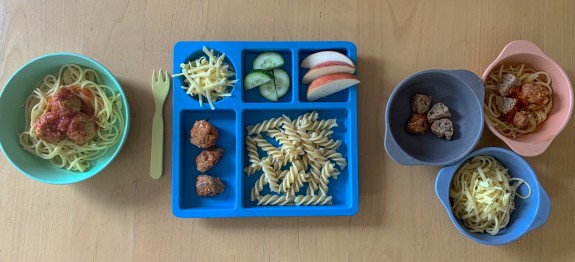Meatballs 3-ways for fussy eaters
Meatballs 3-ways for fussy eaters
Slow cooked meatballs are tender, delicious and can be a favourite meal for kids and the whole family – and the texture is perfect every time. But not all kids! Some of mine enjoy them, some of them don’t. I think I overcooked or undercooked them too often for my eldest when he was little so he is quite averse to the texture – I clearly needed this recipe back then. Whereas my youngest can eat more of these meatballs than I can when his appetite is at his best. Depending on how your child likes to eat, there are a variety of ways you can offer these meatballs to encourage acceptance and enjoyment if they are a new food or regularly refused meal. Here are 3 tactics that have worked for me, with either pasta meals or other foods I’m introducing to my kids.
{The bamboo bowls and plate featured in these images are from bobo&boo. Use the code: ONEHANDEDCOOKS for 10% OFF their entire range.}
1. IN A BOWL LIKE YOU
Sometimes kids just want to eat them the way you do (if that’s how you enjoy spaghetti and meatballs) – in a bowl with some spaghetti, maybe some fruit or veg on the side – or not. Sitting down as a family and enjoying a meal together creates safe and secure mealtimes for children and allows you to role model positive eating behaviours. Twist and twirl the spaghetti together – it’s messy and fun and engaging for toddlers. You can help your child serve the spaghetti and meatballs from the centre of the family table. Or perhaps try mashing up the meatballs if you need to to resememble spaghetti bolognese if that’s what they usually enjoy. You can gradually reduce the amount of mashing you need to do and simply halve or quarter the meatballs.

2. ON A TASTING PLATE
Oh, how we love the tasting plate. A child is a lot more accepting of a new food when they see it deconstructed among some of their other favourites. And especially when everything is kept separate from one another! As they satisfy some of their hunger with the foods they do like, the new foods can suddenly seem less threatening and more engaging and they may like to try a bite. The tasting plate works best when offered without pressure and your child can eat which foods they wish, and how much, from those on offer.

3. USING 3 BOWLS
The old’ 3 bowls trick. This is really helpful for kids who are becoming older, who like the meatballs and like the pasta BUT don’t like them when they’re mixed together. Continuing to serve them separately but also beginning to (and continuing to) introduce them to a small, mixed portion will help them become more familiar it, and will in time (again without any pressure to try) will give it a go themselves. It takes some patience, persistence and positivity at mealtimes but over time and with exposure they will get there.

Note: Toothpicks or skewers can be a great way to encourage kids to interact with a food, especially for kids who aren’t able to manage cutlery yet and don’t like to touch new foods or get their hands too dirty. Blunt the ends if you need to and always supervise your child while they are eating for their safety.
*Please read our Disclaimer: if you have specific concerns regarding your child’s readiness for starting solids, child’s appetite, eating behaviour, growth/development or the nutritional adequacy of their diet we recommend you consult your medical practitioner for assessment and referral to an appropriate health care provider, e.g. an Accredited Practising Dietitian (APD), GP, Paediatrician or Child and Family Health Nurse.
Join us on Facebook for other foodie bits and pieces.





























posted by priscilla stasi on February 13, 2022
I am a grandmother trying to feed a 3 1/2 year old very fussy eater